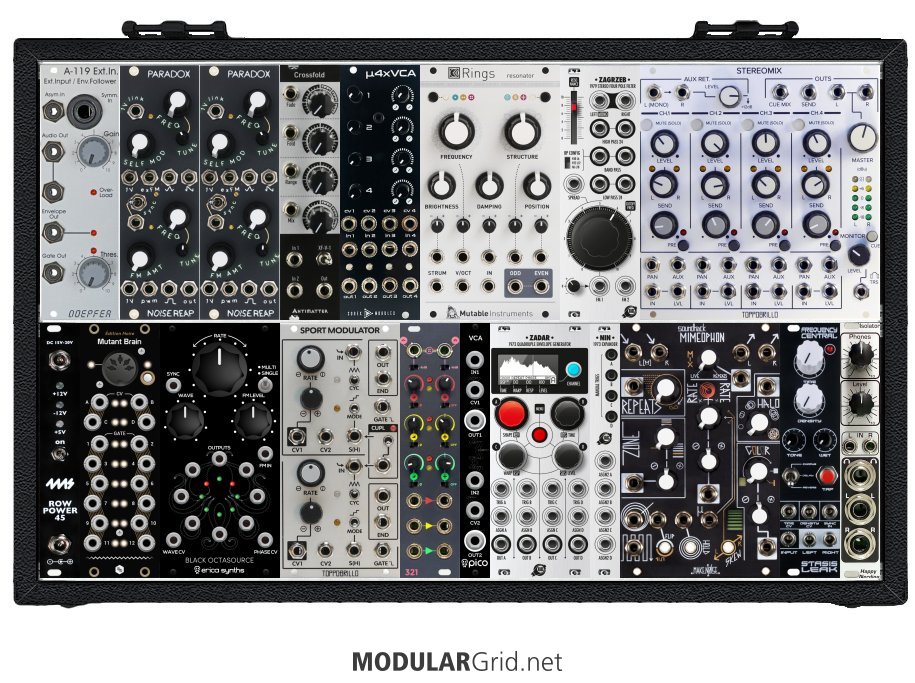This rack is planned to be paired with a digitakt.
I want this to be very performative, even change it´s patch live.
A 2 voice and effect procesor is the goal here.
This rack is planned to be paired with a digitakt.
I want this to be very performative, even change it´s patch live.
A 2 voice and effect procesor is the goal here.
Hmm...OK, for starters, you won't need two P/Ss. One of several hefty power supplies on the market can supply the juice for the whole cab. You just have to make sure that you've still got about 25% MORE capacity than the modules themselves draw so that you can avoid problems with current inrush when switching the modular on. Choosing proven Eurorack supplies is something I recommend as well, since that one component has the highest potential for causing trouble for the entire rig.
[short pause to wail on rack above]
OK...well, this came out fairly well, but you'll notice some things immediately missing, with the most notable example there being the Plasma Overdrive. I just don't think it's a really good idea to put some sort of gas discharge tube inside a closed-up cab where there's plenty of opportunities for any electrical noise from that module to get into all sorts of other things.

TOP: I got rid of the Intellijel I/O, deferring instead to the more useful (albeit mono) Doepfer A-119, which gives you an envelope follower so your input levels can be extracted to use as a modulation source. The A-119 also provides a gate (with threshold) that can key at your desired level. Next is a pair of Noise Reap's take on dual VCOs, the Paradox. These have a "sorta-sync" and some odd FM capabilities that you don't tend to see in this module size. Very timbrally versatile. Plus, as if that wasn't enough, Antimatter's Crossfold Waveshaper lets you take outputs from TWO oscillators and "smushes" them together, along with the more typical wavefolding duties. That module also replaces the Plasma Overdrive, and does so with a much more capable module. Codex Modulex's clone of Veils gives you four VCAs with the typical Veils features...variable response curve, breakable mixbus, etc. After this, I set Rings in there so that it functions as a "filter" with mono-in/stereo-out. Similarly, the Zagrezb has a stereo out as well. So with a pair of stereo signals incoming, plus the point about FX, I put in a Toppobrillo Stereomix2. This mixer has VCAs on all four inputs, plus CV control over panning and AUX send, and it also has a mono-out/stereo-in FX bus, CUE bus capabilities (which helps with the tweak-on-fly needs), mutes per channel...in short, it's a far better idea as it'll be a good fit for live work, studio or otherwise.
BOTTOM: There's the power supply. I overspecced the HELL out of it so that you can reuse the P/S (a 4ms Row Power 45) in larger builds later on. Plus, by having a P/S with a LOT of current headroom, it will run cooler, which you definitely want as heat is a component-killer, plus it can lead to plenty of instabilities due to thermal effects. MIDI interface next, then the Octasource. The Octasource is interesting...unlike the Ochd which is seeing a lot of use as of late, this LFO only has one rate being outputted...but via a phasing network so that you have offsets every 45 degrees with the same waveform. This fits really well with the various modulation schemes here...the Paradoxes alone can be made to act VERY nuts with this LFO. Next from Toppobrillo is their half-a-Maths, the Sport Modulator2. No room for Maths? This is a damn good substitute, which uses the same sort of Serge Dual Universal Slope Gen core as Maths, etc, but with the few odd tricks of its own. The Frap 321 and Erica PICO VCA are the "manipulation core" for your modulation signals, so that you can add offsets, invert signals, mix 'em, and on and on. Then the envelope duties are handled with a Xaoc Zadar (and Nin expander). Then the next two modules are your effects...the Mimeophon (which would make a good destination for the Rings' stereo output, actually) and a Frequency Central Stasis Leak...tap delay, chorus, reverb with a mono in and stereo out...just like the Stereomix2 wants. Then the final outs are last, via one of the updated Happy Nerding Isolators...which not only gives you a pair of balanced 1/4" outs, it has a 1/4" out for your headphones as well. So you can monitor the mix from that...or if you need the cue, just shift the headphone plug to the Stereomix2's headphone out.
Not too shabby, I think...this hits all of the desired points, plus it's really good with ergonomics and control density as well.